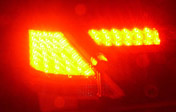Thanks to the increased effectiveness and development of also white LEDs, (Light-Emitting Diodes), the deployment of light-emitting diodes has become possible in a number of different fields. Apart from LED signal systems and large displays that can be used during the day, LEDs are also used for illumination.
LEDs are monochromatic and only shine in a specifically and precisely demarcated spectral range. White light can be generated by using LEDs of various colours.
As the spectra and emitting performance of LEDs did not enter a dangerous range for a long time, and since the measuring and classification regulations specified in EN 60825-1- which were intended for lasers – only found insufficient applicability for LEDs, only little attention was paid to the fact that there was an explicit equality with lasers.
The systems that are available nowadays incorporate LEDs which emit brighter light and higher energy in the (blue) spectrum that enter potentially dangerous areas for the eyes.
New: EN 62 471 Safety of lamps and lamp systems.
LED classification according to EN 62 471
The safety classification of incoherent (broad-band) sources is stipulated in EN 62471:2008 and is based upon the maximally permissible emission over the entire range of the product’s performance during its operation at any point in time after it has been manufactured.
This classification considers the extent of artificial optical radiation, the spectral distribution and accessibility to the artificial optical radiation. Broad-band sources are subdivided into four risk groups: the higher the risk group, the greater the danger of injury.



